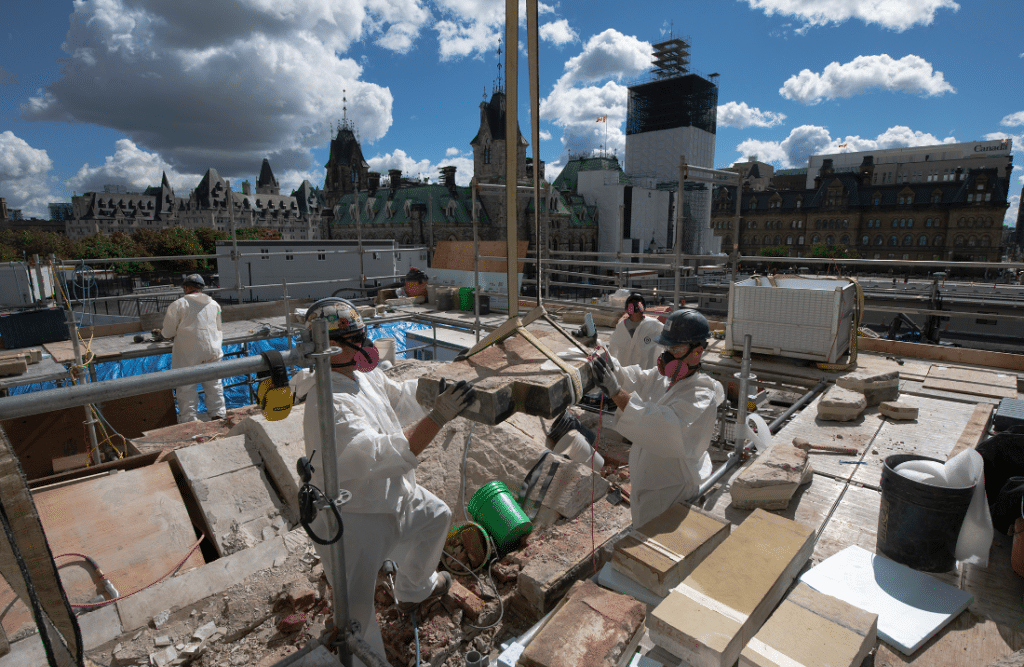CaDCR staff writer
The $4 to $5 billion Centre Block restoration at Parliament Hill has some unique and never-before-done engineering and construction challenges, representatives of the contractors working on the multi-year project say.
Project superintendent Justin Houle and structural lead William Coleman from the joint venture of PCL and EllisDon, told a gathering last Wednesday co-ordinated by the Ottawa Chapter of Construction Specifications Canada (CSC) that they need to work within 3 mm. tolerances, and stretch some equipment to its specifications limits to meet the project’s demanding engineering challenges.
 The project encompasses developing a new visitors’ centre/entrance under the building’s front lawn, while extensively restoring the existing structure without altering its facade or appearance.
The project encompasses developing a new visitors’ centre/entrance under the building’s front lawn, while extensively restoring the existing structure without altering its facade or appearance.
However, to meet the challenges of making the building safe seismically, contractors need to dismantle the building’s foundation and support the structure with hundreds of piles and jacks, as 90,000 cu. m. of bedrock are excavated below.
Then dozens of “base isolators” will be put in place. These act as giant shock absorbers.
 “The building rests on hundreds of piers, each topped with a pliable disc. The disc combines steel, lead and rubber components that flex and deform in response to seismic waves, effectively decoupling the building from the ground it rests on. While the ground around it shakes violently, the building simply sways gently from side to side,” says an article published by the Senate of Canada in January, 2021.
“The building rests on hundreds of piers, each topped with a pliable disc. The disc combines steel, lead and rubber components that flex and deform in response to seismic waves, effectively decoupling the building from the ground it rests on. While the ground around it shakes violently, the building simply sways gently from side to side,” says an article published by the Senate of Canada in January, 2021.
“You actually float the building on a series of what are, essentially, rubber pucks,” Andrew Wisniowski, Public Services and Procurement Canada’s director of designs and approvals for the project, was quoted as saying.
“When the earth shakes, these pucks absorb the loads acting on the building and prevent the structure from being shaken laterally.”
None of this work is simple said Houle and Coleman, representing the construction consortium. Their audience of about 125 people listened to their observations at the Canadian History Museum in Gatineau, in a room overlooking the construction site.
Specialized pile driving equipment, able to work in confined spaces, needed to be imported – and that equipment was designed for much smaller projects, requiring less intensive continuous operation. The solution: careful maintenance and back-up resources to ensure the machinery can handle the tasks.
As well, to maintain tolerances, temperatures need to be managed both in the winter and summer, with heating and temporary/permanent (because of the project’s duration) systems installed to ensure everything remains within the extremely strict tolerances.
The contractors say their task, when the project is expected to be completed early next decade (the original schedule calls for it to be finished by 2031), is for the building to look on the exterior almost exactly like it did before the renovation.
But within the structure, all the electrical, plumbing and ventilation systems will be modernized and new offices and public areas will be constructed, as traditional and iconic areas such as the House of Commons and Senate Chambers will look almost exactly like they did before the restoration – with the improvements hidden behind the walls. The work also includes a new seventh floor and a glass roof over the existing interior courtyards.
This sort of work — keeping an existing building on its original site, but rebuilding its foundation and interior while adding new hidden resources and services — is indeed costly.
“So what you’re saying is, in 1917, when the original buildings burned down, it took a year to rebuild everything they put it on Model T Ford Foundation,” said Robert Merkley of Merkley Supply Ltd.
“We’ve now put on, not a Rolls Royce but a Lamborghini foundation. Who’s paying for this? What’s the status of the budget? I’ve never seen anything like this before?,” Merkley asked.
“I don’t think I have a great answer for that,” Houle responded. “It is an expensive program. I don’t think you’ll see another program of this calibre just because of the heritage aspect of the building and what they require for the program.
“I do think they were doing all this because they print the money there,” Houle quipped.
William Coleman noted that building needed two separate mechanical/ventilation systems, one on the rooftop and the other in the basement, to handle all of the modern requirements. As well, the existing structure was badly in need of updating.
“The space required for these new mechanical systems to climate control the building . . . and then to accommodate all this extra space requires these upgrades as far as the base isolation system to me today’s building codes, it’s just it was it was better value for your dollar compared to revamping the entire skeletal structure of the building,” said Coleman.
“When I questioned some of the designers’ audit and why we’re doing what we’re doing the building definitely needed a major facelift,” Coleman said after Merkley observed that the project is costing about $5,000 per sq. ft.
The Senate article published in 2021 notes that the base isolation system offers “compelling benefits.”
“It performs better during earthquakes, sparing the building all but superficial damage. Moreover, it’s faster and cheaper to install — as much as $200 million cheaper in Centre Block’s case — and has far less impact on the building’s heritage fabric.”





